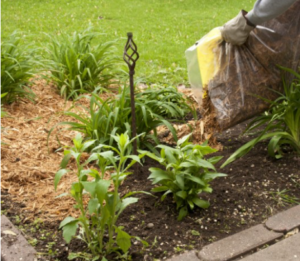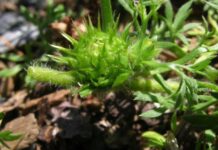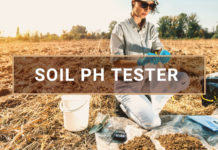
Not only are weeds unsightly on your flower bed, but they also rob water and nutrients from the other plants as well. Left uncontrolled, they can take over entirely and your beautiful flowers won’t get a chance.
For a great many reasons, weeds are notoriously difficult to get rid of. Some drop seeds and germinate unbelievably quickly while others develop deep and complicated root systems underneath the soil that seems almost impossible to remove.
It is important to get rid of weeds to protect your beautiful flowers and the rest of your plants. There are lots of ways to try it.
1. Stop Them Before They Start
It’s always better to be proactive against weeds than to try to get rid of them once they have taken over your flower bed. The most successful way to do so is to make sure that before planting your flowers, the soil is free of weeds and any weed seeds.
That’s not always easy, admittedly, as some weeds lie dormant underground just waiting for air exposure to come to life. Carefully hunt and remove anything you find, so you can start with the cleanest possible soil.
Make sure you do not add any weeds accidentally to a clean bed, too. When planting new plants, take a close look at them to make sure there are no small weeds present. Pull them away if you find any, before growing the plant in the soil.
If you compost, make sure it is old enough so no weed seeds will take root. Or, even better, keep the clippings out of the compost stack. The weeds can quickly germinate and spread and there’s a good chance you’ll just add them back to the flower bed right away.
2. Solarization
This is a time-consuming method but if you are willing to put the time in, it can be quite effective. Heating the soil can kill both weeds and their seeds, before adding flowers.
Raising the soil surface then generously waters it up. Next, cover it with a large sheet of heavy plastic tarp. To keep the plastic in place, place rocks, bricks, or other heavy objects around the edges. The sun’s humidity and heat should create enough heat to make this work.
Water the area around the plastic to keep it moist, regularly. The soil would have had enough heat exposure after about eight weeks to destroy any weeds or seeds.
3. Plant Groundcovers
The basic idea here is that if every area of soil in your flower bed is covered with a plant, weeds are not going to have to grow anywhere. As your flowers grow and the ground cover weaves around their stems and covers all the exposed dirt, you can create a thick, lush look too.
Some good plants for this are Creeping Thyme, a short plant for a long, dramatic look with tiny bright pinkish-purple flowers, or Japanese sedge grass. Try out shadow-loving hostas for something lush and green.
It’s important to consider how tall it grows when choosing a groundcover plant. While it makes a beautiful accent that helps to keep weeds away, a ground cover shouldn’t be larger than the flowers featured in your bed.
4. Mulching
Mulching only uses the same idea as groundcover rather than filling the spaces with plants, instead, you use mulch. Applying mulch is much simpler than planting ground cover and you can pick from different styles and colors to match your home’s exterior, upping curb appeal.
The use of a thick layer of mulch is important. Seek about 6 inches of organic matter. The weight will not only prevent weeds from pushing through but it will also help the soil retain moisture.
Alternatively, you can use underneath a plastic sheet or landscape fabric and use a thinner mulch layer. The fabric adds an additional barrier and should have the same effect.
 5. Hand Weeding
5. Hand Weeding
It is the most time-consuming and boring choice of all but if you can get the whole weed down to the root it is very good. The best approach is the regular weeding of the flower bed. It is much easier to grab seedlings when they are small than trying to cut the difficult roots when they are bigger.
Bear in mind that this process may actually take years for large weeds with deep roots but once you get it under control the weeds should be eradicated. In the long run, the investment is worth it. Every few weeks, take out big weeds as small as possible. Keep doing so before the return ends.
Hand weeding can be very hard physical work but there are plenty of tools for help. Use a hand weeder with a sharp, narrow tip to get right down into the roots or a sharp hoe just under the surface to hack through the roots.
To avoid cross-contamination or inadvertently spreading weeds, be sure to thoroughly clean your gardening tools every time you get weeded.
6. Herbicides
A further effective option is chemical herbicides. Some gardeners prefer not to use it as a last resort while others use it as their first line of defense.
Herbicides are very effective against weeds but must be used very carefully so that other plants in your flower bed do not get harmed. They can also be harmful to pets or small children, so using them with caution is necessary.
Remember that different kinds of herbicides function in different ways. It is important to select one when working in a flower bed which will cause the least amount of damage to the beautiful flowers surrounding the weeds.
Contact herbicides work by destroying the part of the plant they come into contact with which means they are not so effective at getting to the roots or any other underground parts of the weeds. That said, they are working really fast at destroying the surface weeds.
Usually, systemic herbicides accumulate through the leaves and are transferred through the plant. Though these herbicides work slowly, they are successful in the timely killing of the entire plant.
If a chemical herbicide has to be used, try one that combines both contact and systemic action to get the benefits of each.
One positive thing about herbicides of this sort is that you have to apply them directly to the plant. That means they should have no effect on nearby flowers as long as your carefulness.
Final Thoughts
A full-frontal solution that incorporates all those approaches is the perfect way to combat weeds in your flower bed. Note, some weeds lie dormant in the soil before sunshine and fresh air reach them and you never really know what you’re dealing with right away.
Still, it really is important to start with the cleanest flower bed possible. Depending on the type of plant you are dealing with, making the soil fully clear can be next to impossible. However, the less weeds you begin with, the easier it is to manage them.
After removing what you can, and allowing solarization to do its work, add mulch, groundcover, or some other barrier to protect everything left behind.
Lastly, if something manages to sneak through despite all your hard work, usually it takes manual removal or chemical herbicides.
Also, See 8 Best Weed Killer for Flower Beds – 2024 Buying Guide

 5. Hand Weeding
5. Hand Weeding




